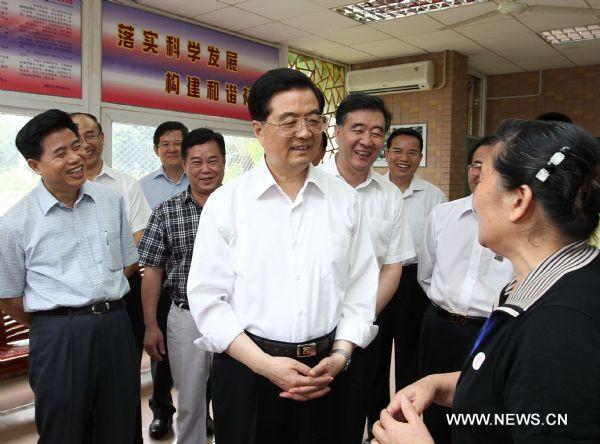
Chinese President Hu Jintao talks with the residents at Yumin Village of Luohu District in Shenzhen, south China's Guangdong Province, on Sept. 5, 2010. Hu called for more innovation and increased use of clean energy during a recent tour of Shenzhen, before he attended a celebratory rally marking the 30th anniversary of the country's first special economic zone. (Xinhua/Ju Peng)
President Hu Calls for More Innovation
Chinese President Hu Jintao called for more innovation and increased use of clean energy during a recent tour of Shenzhen, before he attended a rally marking the 30th anniversary of the country's first special economic zone (SEZ).
At Tencent Inc., one of China's largest Internet portals, Hu learned that the company's 12,000 staff have an average age of only 27 years and that 85 percent have college degrees. Hu encouraged young people to innovate and contribute to the nation's Internet industry.
At the Shenzhen Institute of Advanced Technology, part of the Chinese Academy of Sciences, Hu observed recent technological breakthroughs in high-tech enterprises such as car maker BYD and telecommunications equipment makers Huawei and ZTE.
Hu also visited the Daya Bay Nuclear Station, known as the "cradle" of the country's nuclear power industry. Statistics show the Daya Bay and Ling'ao nuclear power stations deliver more than 95 million kilowatt-hours of electricity to Guangdong and neighboring Hong Kong each day.
Hu added that nuclear power is a world-recognized "clean energy," which is an important way for China to "optimize the country's energy structure" and "cut green house gas emissions." China's nuclear power industry is still "fledgling" but is "developing fast," said Hu.
Hu also visited Yumin (fishermen) Village Community in downtown Shenzhen, and examined residents' living conditions. Yumin was a fishing village 30 years ago but is now a modern urban community, with its villagers all urbanites.
In 1984, the late Chinese leader Deng Xiaoping, who first proposed building Shenzhen into a SEZ in the late 1970s, also visited the village.
"The community's great change epitomizes the development of the Shenzhen SEZ and proves that the reform and opening-up policy is a must for national prosperity," said Hu who added that people should be grateful to the opening up policies of the late Deng Xiaoping.
Related News
Photos
More>>trade
market
finance
- Chinese Premier Wen Jiabao meets Macao chief executive
- President encourages HK tycoon to contribute more to national modernization
- Preview of Hong Kong Int'l Art and Antiques Fair
- Phillippines hold mass mourning for HK victims
- Vice president urges HK business group to contribute to regional development





